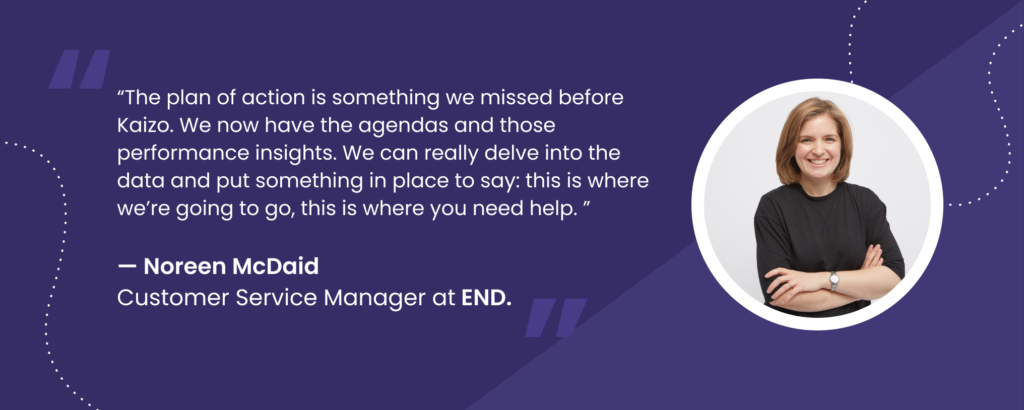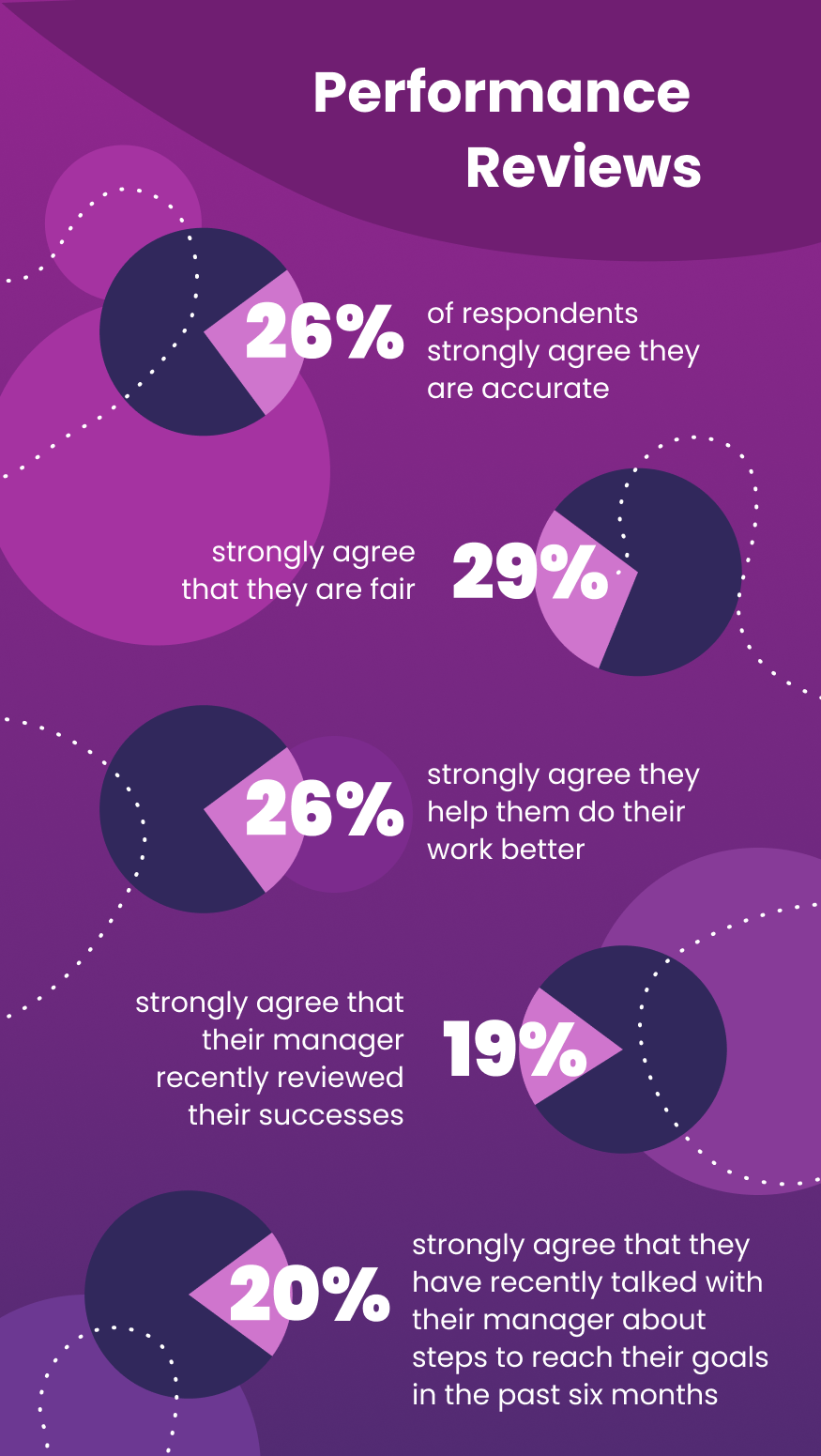Performance management process is essential to get right and easy to get wrong – but it is crucial to building success in your customer service teams. It can help you align them with all strategic objectives.
Unfortunately, the performance management process is slow in many customer support teams — yet it is key to improving efficiency. It helps you adjust and correct course before any major roadblocks can occur.
Performance management processes aim to improve performance, but traditional approaches have consistently fallen short of this goal. Remote working has not necessarily made it any easier for managers to support their teams. Not to mention cultivating a continuous performance management cycle. Despite the difficulties, more companies have started shifting from annual appraisals to a more consistent yet informal approach to performance management.
Often, yearly performance reviews are daunting to employees. They have to walk into a meeting with a manager they may not have had contact with for a while. Trying to remember goals set months ago and defending any mistakes they may have made can place them under unnecessary stress.
But, an effective performance management process can help you inspire and retain your workforce. According to research by Gallup, 24% of employees would consider leaving their job if they’ve received inadequate feedback.
What is a performance management process?
According to Armstrong and Baron, a performance management process is defined as “a process that contributes to the effective management of individuals and teams in order to achieve high levels of organizational performance. As such, [it] establishes a shared understanding about what is to be achieved and an approach to leading and developing people which will ensure that it is achieved.”
Simply put, a performance management process is a communication-based process where managers work with their employees to continuously monitor and review objectives, goals, and job trajectories.
This process allows you to coach and develop your teams to cultivate a performance management and achievement culture. Understanding the performance management process and practice can help customer service team leads become skilled in setting expectations. These need to be clear, collaborative and aligned with company and personal goals and objectives.
Why is a performance management process important?
Monitoring, praising, and criticizing employees is part and parcel for managers and team leads – but it can also be awkward and uncomfortable. Yet, the Gallup State of the American Workplace study found that increasingly, employees want to be engaged and thrive on meaningful, constructive feedback — and customer service teams are no exception.

To revise and improve the performance management process, managers and leaders need to understand why so many employees feel their performance reviews are inaccurate and unfair. Only then can we modernize and automate performance management. The most valuable insight gained from the study is the need for individualizing performance management, which can be achieved with frequent, clear, and concise feedback.
What are the basic elements necessary for effective performance management?
Now that you know you definitely need to improve your performance management process, it’s time to start.
There are many different approaches and performance management process templates — but no one-size-fits-all for effective performance management. How you decide to improve your employee performance will depend on the metrics you use to evaluate their success. It could even be a combination of different performance management approaches throughout the year.
Overview of Performance Management Processes
- Critical incident method (CIT)
By describing specific events CIT can help to put the performance in context. It illustrates patterns of employee performance and behavior.
- Management by objectives (MBO)
When you agree and set measurable goals and objectives for the organization, different departments, and individuals you can measure employee performance against their goals.
- Performance management process checklist
The checklist method is simplistic, consisting of a series of ‘yes’ or ‘no’ statements regarding improved quality assurance and customer service. Examples could include: Is the agent punctual/helpful to his/her team members / reliable / engaged in his/her work etc.
- 360-degree performance appraisal
This performance management approach involves collecting information about an individual’s performance from managers, team leads, and their peers. It is a group review to help focus their development by providing feedback from different sources.
- Competency-based
Instead of measuring performance based on MBO, this management approach focuses on performance measured against an individual’s specific competencies for their position.
- Graphic rating scale (GRS)
Similar to the performance management checklist, the GRS lists characteristics and behaviors to rate an employee’s performance according to graduation or score (unsatisfactory, satisfactory, excellent).
Strong performance management rests on the basic principle that “what gets measured gets done.” So, no matter which approach you decide to take, make sure that the feedback you provide is constructive and goal-oriented to help employees improve their performance and assist with career development.
“Coming together is a beginning; keeping together is progress; working together is success.” – Henry Ford
What are the steps of a performance management process in customer service?
Introducing an effective performance management strategy in customer service is akin to developing a new work culture. It may not always be easy, but leaders who form the habit of continuous, honest, and constructive feedback will lead their teams to greater success. So, what are the steps in the performance management process in customer service?
1. Planning
This first step requires the manager to clearly identify what they expect from their employees’ performance and what they are looking for when they review an employee’s progress towards meeting those expectations. The manager must also determine how they will collect and evaluate data on employee progress towards meeting expectations.
In customer service, the first step of an effective performance management process is to start with a plan. In this step, you first need to define the agent’s role. A comprehensive job description, aligned with the person’s job expectations can go a long way to improve their performance within the role.
Collaborate with agents to set S.M.A.R.T goals — an achievement-oriented review can help you re-frame ongoing conversations around future performance.
But there’s a secret here. For your agents to achieve more goals, you need to materialize them somehow, put them on paper, use a coaching tool to set them, whatever works for you as long as it’s not just a verbal agreement.
Using Kaizo, you can set different goals (Missions), telling your agents what they need to achieve (for example, a CSAT of 80%) and by when. Then you can check your agents’ progress as they move closer to the finish line, giving them extra tips and guidance.

Once they hit their goals, your Agents will receive gamified rewards to celebrate their success and encourage them to perform even better!
This is actually a tried and tested method which has proved to be particularly effective in customer service teams that work in retail. Endclothing, a fashion retailer from the UK, has adopted that new method of goal setting and managed to build a driven team that continuously delivers stellar performance outcomes!

Read more: How END. built their best support team ever
2. Monitoring
Monitoring your customer service team’s performance doesn’t mean hovering over their shoulder, being a helicopter parent, waiting for the first sign of trouble to swoop in and take over. But a daily, conversational 5-minute check-in can help you to identify key issues or roadblocks.
Negative issues can be addressed during regular conversations, coachable moments identified and accomplishments praised. After all, frequent, honest conversations improve their perception of fairness and keep them accountable.
Set up a system for tracking your employee’s progress against their goals. This could be as simple as using a stopwatch or a spreadsheet that keeps track of every call made and its results, but it needs to be something you can easily access so you can keep an eye on whether or not they’re meeting their targets.
3. Review
Your review process will depend on which performance management process approach or template you use and where you fall in the performance management cycle. But, effective performance management includes reviewing your reviews. It includes planning, monitoring, feedback, and coaching, as an ongoing process, not just an annual event. Your review should be measured according to the goals you’ve set.
The reviewing phase involves managers watching employees to see if they are following procedures and policies and if they are giving quality service to customers. Managers watch employees in action during every contact with customers and document these observations in a contact log. This step can be time-consuming, but it is essential so that managers can correct improper behavior before one customer complaint leads to others.
Read more: 17 unique ways to improve quality assurance in a call center in 2022
4. Feedback
Based on how well the employee is meeting their goals, provide them with positive reinforcement when they’re doing well (and make it clear that exceeding expectations is just as good as meeting them) and provide some constructive criticism when they aren’t achieving the right results.
The best way to do this is by setting clear goals and expectations at the beginning of each term (whatever it is in your case). Then, during your monthly or weekly check-ins you can ask how they’re doing on those goals and if there are any obstacles in their way. If they’re not meeting expectations, take note of what they need help with and provide them with resources or training where appropriate.
Constructive feedback is one of the key components of the performance management process. The way in which you approach your feedback will be crucial to an agent’s performance.
Framing
Frame your feedback as a Net positive statement. For example, instead of saying: “to be honest, I don’t really know what you’re trying to say here…” try, “I think you’re off to a good start; however there is room for improvement…”
Provide context
It is essential to be specific to identify where an agent stumbled. The good news? Kaizo makes it easier than ever to track performance metrics and goals to better pinpoint areas of improvement. Using those areas and create a guided plan towards improvement with the help of Coaching Cards. In these cards, you can explain your Agents what they need to improve, why, how, and by when. It’s like taking goal-like notes on a feedback sessions, notes that motivate you to do better.
Here’s what they look like.

Timing
There is a difference between saying ‘good job’ in passing and improving your performance management process with continuous constructive feedback. Establishing performance check-ins throughout the year and providing feedback on a consistent, frequent basis. It is critical to let agents know where they need to improve so they can excel as the year progresses.
In an ideal world, a business creates various metrics and targets from top to bottom — including all daily activities for their frontline employees. Managers can then continually monitor those metrics and regularly engage their teams to discuss performance and meeting targets. Good performance gets rewarded. Underperformance is addressed with an actionable plan to improve performance.
With Kaizo’s performance management tools, you can save time monitoring your team’s performance — because it is all there — in one handy dashboard.
Final thoughts
Today’s agents want more from their companies. Attitudes are shifting and they want meaningful work and managers who provide clear ongoing communication, coaching, and mentoring.
They expect employers to set clear work expectations and provide them with opportunities to learn and grow. With only 20% of employees surveyed having any type of performance review to assist in their progress, automation of performance management processes could help you coach and mentor your agents effectively, and on a regular basis. Your performance management process should aim to develop and inspire agents to achieve their goals and objectives.

Luckily, this doesn’t mean a complete overhaul of your traditional performance management practices, including annual 360-degree performance appraisals or GRS reviews. But, managers and team leaders in customer service would be remiss to not improve the way their performance management systems work. When done correctly, effective performance measurements provide accountability, fairness in evaluation, and actionable advice on areas of improvement.
An effective, continuous performance development approach helps managers to better assess an agent’s strengths and weaknesses. It helps to establish achievable goals and manage expectations that are tailored to their development needs. Investing in the automation of your performance management process could not only save you time but also help you to provide accurate feedback and coaching to your customer support teams. It also helps to create greater accountability and ensures that everyone knows how to reach their goals.
If you would like more information on how Kaizo can improve your performance management process and the productivity of your team, schedule a demo with us!


